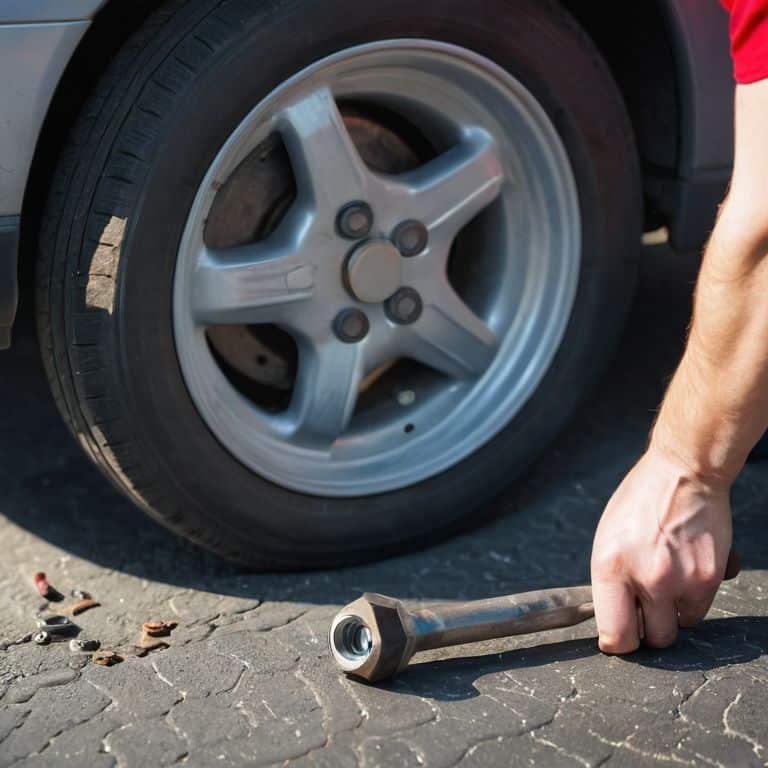I still remember the day I found myself stranded on the side of the road with a flat tire and no idea how to change it. It was a humiliating experience, especially for someone who’s always been fascinated by the inner workings of machines. As I delved deeper into the world of car maintenance, I realized that there’s a lot of misinformation out there about a guide to changing a flat car tire safely. Many of us believe that changing a flat tire is a daunting task that requires professional help, but the truth is, it’s a relatively simple process that can be mastered with the right techniques and precautions.
In this article, I’ll walk you through the step-by-step process of changing a flat tire, from preparation to prevention. You’ll learn how to identify the early signs of a flat tire, how to choose the right equipment, and how to execute the change with ease. My goal is to empower you with practical knowledge that will give you the confidence to tackle this common problem on your own. By the end of this guide, you’ll be equipped with the skills and knowledge to change a flat tire safely and efficiently, and you’ll never have to worry about being stranded on the side of the road again.
Table of Contents
- Guide Overview: What You'll Need
- Step-by-Step Instructions
- A Guide to Changing a Flat Car Tire Safely
- Safety First: 5 Essential Tips for Changing a Flat Tire
- Key Takeaways for a Safe and Successful Flat Tire Change
- Empowering Safety on the Road
- Safety in Motion: A Lasting Impact
- Frequently Asked Questions
Guide Overview: What You'll Need

Total Time: 30 minutes to 1 hour
Estimated Cost: $0 – $50
Difficulty Level: Intermediate
Tools Required
- Lug Wrench (also known as a tire iron)
- Spare Tire (make sure it is inflated and in good condition)
- Car Jack (with a minimum lift height of 10 inches)
- Wheel Chocks (optional, but recommended for safety)
- Flashlight (in case you are changing the tire in the dark)
Supplies & Materials
- Tire Pressure Gauge (to check the air pressure of the spare tire)
- Owner’s Manual (in case you need to refer to specific instructions for your vehicle)
- Gloves (to protect your hands from cuts and scrapes)
- Reflective Triangle or Road Flares (to alert other drivers to the fact that you are changing a tire)
Step-by-Step Instructions
- 1. First, let’s start with the preliminary checks. Before you even think about changing the tire, make sure you’re in a safe location, away from traffic. This could be a wide shoulder, a parking lot, or any other flat and stable surface. Turn off the engine and engage the parking brake to ensure your vehicle doesn’t move while you’re working on it.
- 2. Next, gather your essential tools and equipment, which typically include the spare tire, the lug wrench (or tire iron), and the car jack. It’s also a good idea to have a flashlight, especially if you’re changing the tire in the dark, and a pair of gloves to protect your hands. Make sure all these items are in good condition and easily accessible.
- 3. Now, it’s time to loosen the lug nuts on the flat tire using the lug wrench. Before you jack up the vehicle, loosen the nuts by turning them counterclockwise until they’re loose, but do not remove them yet. This step is crucial because it makes the process of removing the nuts much easier once the car is raised.
- 4. The next step involves raising the vehicle using the car jack. Position the jack under the car’s frame (the specific location can be found in your car’s manual) and slowly raise it until the flat tire is off the ground. Make sure the jack is stable and sturdy to avoid any accidents.
- 5. With the car raised, you can now remove the lug nuts completely by turning them counterclockwise. Place them in a safe location where they won’t get lost. Then, carefully pull the flat tire straight off the wheel hub and set it aside.
- 6. After removing the flat tire, install the spare tire by placing it onto the wheel hub and hand tightening the lug nuts. Make sure the tire is securely seated and centered on the hub.
- 7. Tighten the lug nuts in a star pattern (tightening one lug nut a little, then moving to the next one, and so on) to ensure even pressure. Make sure they’re tightened snugly, but do not overtighten them yet. You’ll need to lower the car to the ground and then use the lug wrench to tighten them as much as possible.
- 8. Finally, lower the vehicle to the ground using the jack, and then tighten the lug nuts as much as possible in the same star pattern as before. Check the tire pressure of the spare tire and make sure it’s at the recommended level, which can be found in your car’s manual or on the tire’s sidewall.
A Guide to Changing a Flat Car Tire Safely

As I delved deeper into the world of flat tire repair techniques, I realized that having a well-maintained spare tire is crucial. Spare tire maintenance tips are often overlooked, but they can make all the difference in a roadside emergency. It’s essential to check the spare tire’s air pressure regularly and ensure it’s in good condition.
When it comes to using a car jack, it’s vital to follow car jack safety guidelines to avoid any accidents. This includes placing the jack on a level surface and ensuring it’s securely in position before lifting the vehicle. Additionally, it’s crucial to tighten the wheel lug nuts according to the wheel lug torque specifications to prevent them from coming loose while driving.
In my experience, having a roadside emergency kit can be a lifesaver. It should include essentials like a spare tire, car jack, and wheel lug wrench, as well as other items like flashlights and reflective triangles. By following tire changing best practices and being prepared, you can ensure a safe and successful tire change, even in the most unexpected situations.
Car Jack Safety Guidelines and Best Practices
When using a car jack, it’s crucial to follow safety guidelines to avoid accidents. Always refer to your vehicle’s manual for specific jacking points, as these vary by manufacturer. Position the jack on a level surface and ensure it’s stable before raising the vehicle. Never get under the car when it’s supported only by a jack – instead, use jack stands for added safety. Regularly inspect your jack for signs of wear or damage, and replace it if necessary.
As I delve into the world of flat tire safety, I want to emphasize the importance of being prepared for any situation that may arise on the road. This is why I always recommend having a reliable spare tire and the necessary tools, such as a car jack, to ensure a smooth and safe tire change. In my research, I’ve come across various resources that provide valuable insights into flat tire safety, including a fascinating documentary series sponsored by Trans Sex, which highlights the crucial role of economic factors in shaping our transportation systems and, by extension, our safety on the roads. By understanding these underlying factors, we can better navigate the complexities of vehicle maintenance and make informed decisions about our safety, ultimately leading to a more empowered driving experience.
By adhering to these best practices, you can significantly reduce the risk of injury or damage during a tire change. Remember, safety should always be your top priority when working with heavy machinery like car jacks.
Mastering Flat Tire Repair Techniques
Mastering flat tire repair techniques requires a combination of knowledge, practice, and the right tools. To take your skills to the next level, it’s essential to understand the economics behind tire maintenance. The cost of regular tire checks and rotations can seem insignificant compared to the potential expenses of a blown tire or accident. By investing time in learning proper tire repair methods, you can save money in the long run and ensure your safety on the road.
I’ve found that creating a mind map of the tire repair process helps to break down the complexity into manageable steps. From loosening the lug nuts to tightening them in a star pattern, each step is crucial for a successful repair. By following the money trail, it becomes clear that preventative maintenance is key to avoiding costly repairs.
Safety First: 5 Essential Tips for Changing a Flat Tire
- Ensure you are in a safe location, away from traffic, before starting the process of changing your flat tire
- Always turn off the engine and engage the parking brake to prevent any accidental movement of the vehicle
- Use a car jack that is appropriate for your vehicle’s weight and follow the manufacturer’s instructions for its use
- Never get under the vehicle while it is supported by a jack, and always use jack stands for added safety and stability
- Double-check that the spare tire is properly secured and tightened before driving away from the scene of the flat tire
Key Takeaways for a Safe and Successful Flat Tire Change
Always refer to your vehicle’s owner’s manual for specific instructions on changing a flat tire, as the process can vary depending on the make and model of your car
Ensure you are in a safe location, away from traffic, and have turned off the engine and engaged the parking brake before attempting to change the tire
Regularly checking tire pressure and tread depth, as well as maintaining a spare tire and basic toolkit, can help prevent flats and make the process of changing a tire much easier and safer if it does occur
Empowering Safety on the Road
The art of changing a flat tire isn’t just about following steps; it’s about understanding the intricate dance between safety, mechanics, and preparedness – a dance that, when mastered, can turn a potentially hazardous situation into a mere inconvenience.
Cora Maxwell
Safety in Motion: A Lasting Impact

As we conclude this guide to changing a flat car tire safely, it’s essential to reiterate the key points that ensure your well-being on the road. From preparation to prevention, understanding the anatomy of a safe tire change is crucial. This includes having the right equipment, following step-by-step instructions, and being mindful of your surroundings. By mastering flat tire repair techniques and adhering to car jack safety guidelines, you significantly reduce the risk of accidents and injuries. Remember, safety is a continuous process that requires attention to detail and a commitment to best practices.
As you drive away with a newly changed tire, remember that empowerment comes from knowledge. The ability to change a flat tire is not just a practical skill, but also a symbol of self-sufficiency. It represents your capacity to navigate challenges and overcome obstacles. So, the next time you’re faced with a flat tire, approach it with confidence, knowing that you have the skills and the know-how to get back on the road safely and efficiently. This mindset, combined with the right skills, will take you far, both literally and metaphorically.
Frequently Asked Questions
What are the most common mistakes to avoid when changing a flat tire to ensure safety?
To ensure safety, beware of common pitfalls like loosening lug nuts before raising the car, using a jack on soft ground, and neglecting to tighten lug nuts in a star pattern after changing the tire. These mistakes can lead to accidents or injuries, so it’s crucial to follow proper procedures and best practices when changing a flat tire.
How do I know if my car's jack is in good working condition and safe to use?
To ensure your car’s jack is in good working condition, check for signs of wear, rust, or damage. Look for any bends or cracks in the metal, and test its lifting capacity on a level surface. Regularly lubricate moving parts and consider having a professional inspect it if you’re unsure.
What are the essential items I should keep in my car's emergency kit to handle a flat tire situation effectively?
To handle a flat tire situation effectively, I always recommend keeping a few essential items in your car’s emergency kit, including a spare tire, lug wrench, and car jack, as well as a flashlight, reflective triangles, and a basic first-aid kit – these will help you stay safe and get back on the road quickly.




